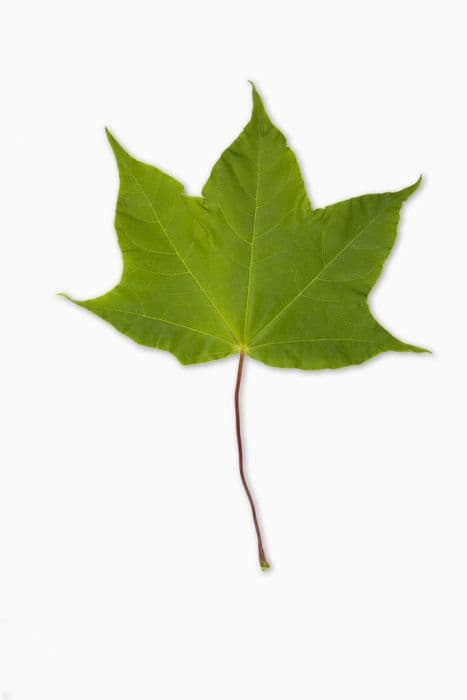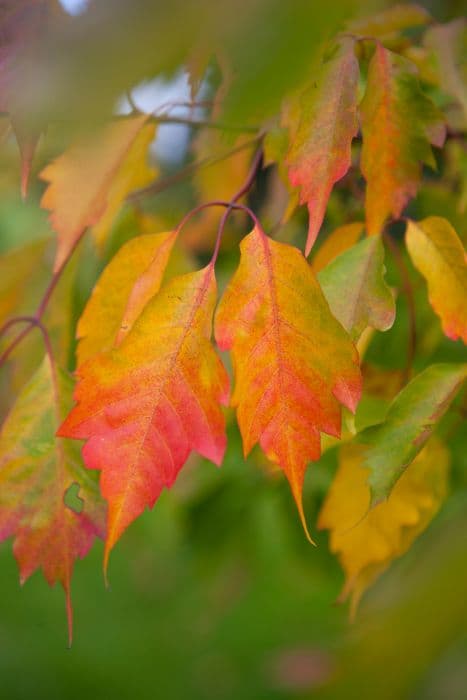Japanese Maple Acer palmatum 'Murasaki-kiyohime' (Dw)

ABOUT
Acer palmatum 'Murasaki-kiyohime', more commonly known as the Japanese Maple, is a visually striking specimen that features a delicate and intricate form. Displaying small, palmate leaves which typically have five to seven pointed lobes, the foliage emerges with a lovely bright green hue in spring. The leaves are intricately veined, lending a fine-textured appearance that exudes tranquility and detailed beauty. As the seasons progress, the leaves of this Japanese Maple variety undergo a fantastic transformation, where the springtime green deepens and is suffused with vibrant purple and red tones, creating a dramatic contrast with its earlier appearance. By fall, the foliage has fully matured into a magnificent array of colors, including deeper purples, vibrant reds, and hints of orange, offering a striking display before the leaves drop. The tree boasts a rounded and bushy growth habit, creating a lush, dense canopy of leaves. Its branches are elegantly arranged, often sweeping outward with a graceful, cascading effect that can resemble a dome-like shape. The intricate branch structure becomes a highlighted feature during the winter when the leaves have fallen, revealing the tree's artistic, skeletal form. With its captivating foliage and alluring growth pattern, Acer palmatum 'Murasaki-kiyohime' is a cherished ornamental plant, often used in landscaping for its year-round aesthetic appeal and its ability to bring a touch of serene beauty to any garden setting.
About this plant
 Names
NamesFamily
Sapindaceae
Synonyms
Japanese Maple, Smooth Japanese Maple, Purple Clearwing
Common names
Acer palmatum 'Murasaki Kiyohime', Acer palmatum var. dissectum 'Murasaki-kiyohime'
 Toxicity
ToxicityTo humans
The Japanese Maple, specifically the Acer palmatum 'Murasaki-kiyohime', is generally not considered poisonous to humans. There are no well-documented cases of toxicity or poisoning from ingesting parts of this plant. Thus, no specific symptoms of poisoning are associated with this plant concerning human ingestion.
To pets
The Japanese Maple, in particular, the Acer palmatum 'Murasaki-kiyohime', is not known to be highly toxic to pets. However, like any plant material, it may cause mild stomach upset if ingested in large quantities. Symptoms such as vomiting or diarrhea could occur but are not typical. It is always prudent to prevent pets from ingesting plants, as individual animals may have unique sensitivities.
 Characteristics
CharacteristicsLife cycle
Perennials
Foliage type
Deciduous
Color of leaves
Green
Height
2 feet (60 cm)
Spread
3 feet (90 cm)
Plant type
Tree
Hardiness zones
5
Native area
Japan
Benefits
 General Benefits
General Benefits- Aesthetic Appeal: Adds vibrant color and unique form to gardens and landscapes.
- Size: Its small stature makes it suitable for smaller gardens or spaces.
- Shade Tolerance: Can thrive in partially shaded environments.
- Seasonal Interest: Provides year-round interest through changing leaf colors and textures.
- Cultural Significance: Often used in traditional Japanese garden design, bringing cultural heritage to your space.
- Wildlife Attraction: Can attract birds and butterflies, enhancing the biodiversity of the area.
- Low Maintenance: Requires minimal pruning and care once established.
- Hardiness: Resilient to many pests and diseases, ensuring long-term health with proper care.
 Medical Properties
Medical PropertiesThis plant is not used for medical purposes.
 Air-purifying Qualities
Air-purifying QualitiesThis plant is not specifically known for air purifying qualities.
 Other Uses
Other Uses- Miniature Bonsai Art: Acer palmatum 'Murasaki-kiyohime' is commonly utilized for creating miniature bonsai due to its small leaf size and compact habit, allowing enthusiasts to cultivate intricate and tiny bonsai landscapes.
- Photography Backdrops: The vibrant colors and fine textures of Japanese Maple leaves are used by photographers as natural backdrops to create visually compelling compositions, especially in macro photography.
- Culinary Presentation: The leaves of the Japanese Maple might be used in high-end culinary presentations as decoration, adding an artistic touch to fine dining plates with its striking foliage.
- Fall Festivities Decoration: During autumn, the Japanese Maple's colorful foliage can be used in fall-themed decorations and centerpieces for celebrations and events.
- Artistic Inspiration: Artists often use the intricate pattern and color of the Japanese Maple leaves as inspiration for paintings, textiles, or other forms of art due to their striking appearance.
- Shade Gardens: Planted in small shade gardens, the Japanese Maple provides texture and color variety without overwhelming the space, complementing ferns and other shade-loving plants.
- Aquarium Landscaping: While not submerged, branches pruned from the Japanese Maple can be utilized in the design of aquarium landscapes to simulate natural habitats for fish.
- Fairy Gardens: With its miniature scale and delicate form, the Japanese Maple is an ideal plant to include in fairy gardens, creating enchanting scenes that capture the imagination.
- Nature Study: The tree can serve as an interesting subject for botanical study, especially for those learning about different leaf types, plant structure, and growth habits.
- Educational Tools: The distinct leaf shapes of the Japanese Maple are sometimes used in educational settings, such as schools or nature programs, to teach children about plant identification.
Interesting Facts
 Feng Shui
Feng ShuiThe Japanese Maple is not used in Feng Shui practice.
 Zodiac Sign Compitability
Zodiac Sign CompitabilityThe Japanese Maple is not used in astrology practice.
 Plant Symbolism
Plant Symbolism- Peace and Serenity: The Japanese Maple, with its calming presence and graceful form, often symbolizes peace and tranquility, providing a sense of calm to any garden setting.
- Elegance and Beauty: With its delicate leaves and beautiful range of colors, the Japanese Maple is a symbol of aesthetic beauty and elegance.
- Balancing Opposites: The changing colors of the Japanese Maple's leaves throughout the seasons, from fresh green to vibrant reds and purples, can represent the balance and harmony between opposite forces.
- Time and Change: The Japanese Maple, through its seasonal transformations, is a reminder of the passage of time and the beauty that comes with change and renewal.
 Water
WaterThe Japanese Maple, specifically the 'Murasaki-kiyohime', should be watered deeply once a week, providing about 2 gallons of water to ensure that the moisture reaches the root zone. During hot or dry periods, increase watering frequency to every 3 to 4 days, while during cooler or rainy times, reduce the watering to every 10 to 14 days. Avoid overhead watering to reduce the risk of leaf disease and instead water at the base of the plant. It is crucial not to let the soil dry out completely but also not to waterlog the soil, as consistent moisture is key to the health of this maple.
 Light
LightThe Japanese Maple thrives best in partial shade to filtered sunlight, avoiding the harsh afternoon sun which can scorch its delicate leaves. The ideal spot is one where it receives morning sun and afternoon shade, or dappled sunlight throughout the day. Protection from strong winds is also beneficial as it can prevent leaf damage.
 Temperature
TemperatureFor the Japanese Maple, the ideal temperature range is between 60°F and 80°F. It can withstand minimum temperatures down to about -20°F for short periods but should be protected from extreme cold. During the growing season, maintaining a temperate and stable environment is vital for the plant's health.
 Pruning
PruningPrune the Japanese Maple in late winter or early spring when the tree is still dormant, to remove dead or crossing branches and to maintain its desired shape. Pruning in this period minimizes sap loss and allows wounds to heal before the growing season. Occasionally, light summer pruning can be done to remove any undesirable or vigorous growth, but it should be minimal.
 Cleaning
CleaningAs needed
 Soil
SoilJapanese Maple 'Murasaki-kiyohime' thrives in well-draining soil that's rich in organic matter. A mix of one part peat, one part pine bark, and one part coarse sand or perlite is ideal. Maintain a soil pH of 5.5 to 6.5 to ensure healthy growth.
 Repotting
RepottingJapanese Maple 'Murasaki-kiyohime' should be repotted every 2-3 years in early spring before new growth starts, using soil with good drainage and aeration.
 Humidity & Misting
Humidity & MistingJapanese Maple 'Murasaki-kiyohime' thrives in moderate humidity levels but is adaptable. Aim for 40-60% relative humidity for optimal growth.
 Suitable locations
Suitable locationsIndoor
Provide bright, indirect light and protect from hot sun.
Outdoor
Plant in partial shade, sheltered from harsh winds.
Hardiness zone
5-8 USDA
 Life cycle
Life cycleThe Japanese Maple 'Murasaki-kiyohime' begins its life cycle with seed germination, which is influenced by environmental conditions such as temperature and moisture. After germination, the seedling emerges, developing a basic root system and its first pair of true leaves. As the tree enters the vegetative growth stage, it develops a more complex root system and a stem that begins to branch out into a recognizable maple form. During the maturation phase, 'Murasaki-kiyohime' reaches its full size and structure, showcasing its distinctive red to purple leaves which mature to green throughout the growing season. The tree then enters the reproductive stage, where it produces small flowers in the spring followed by samaras, or winged seeds, which disperse for future germination. Finally, in the senescence stage, the tree will show signs of aging through reduced growth and productivity until it eventually dies.
 Propogation
PropogationPropogation time
Spring-Early Summer
The Acer palmatum 'Murasaki-kiyohime', commonly known as Japanese Maple 'Murasaki-kiyohime', is typically propagated through softwood cuttings. This is commonly done in early summer when new growth is still flexible and has not yet hardened. Cuttings should be 4 to 6 inches long and include several leaves. The lower leaves are removed, and the cut end is often dipped in rooting hormone to encourage root development. The cuttings are then inserted into a well-draining potting mix and kept in high humidity and indirect light until roots develop, which usually takes a few weeks. The success rate can be improved by providing bottom heat of about 70 degrees Fahrenheit (21 degrees Celsius). Once rooted, the new plants can be gradually acclimated to less humid conditions and grown on until they are ready to be transplanted outdoors.








